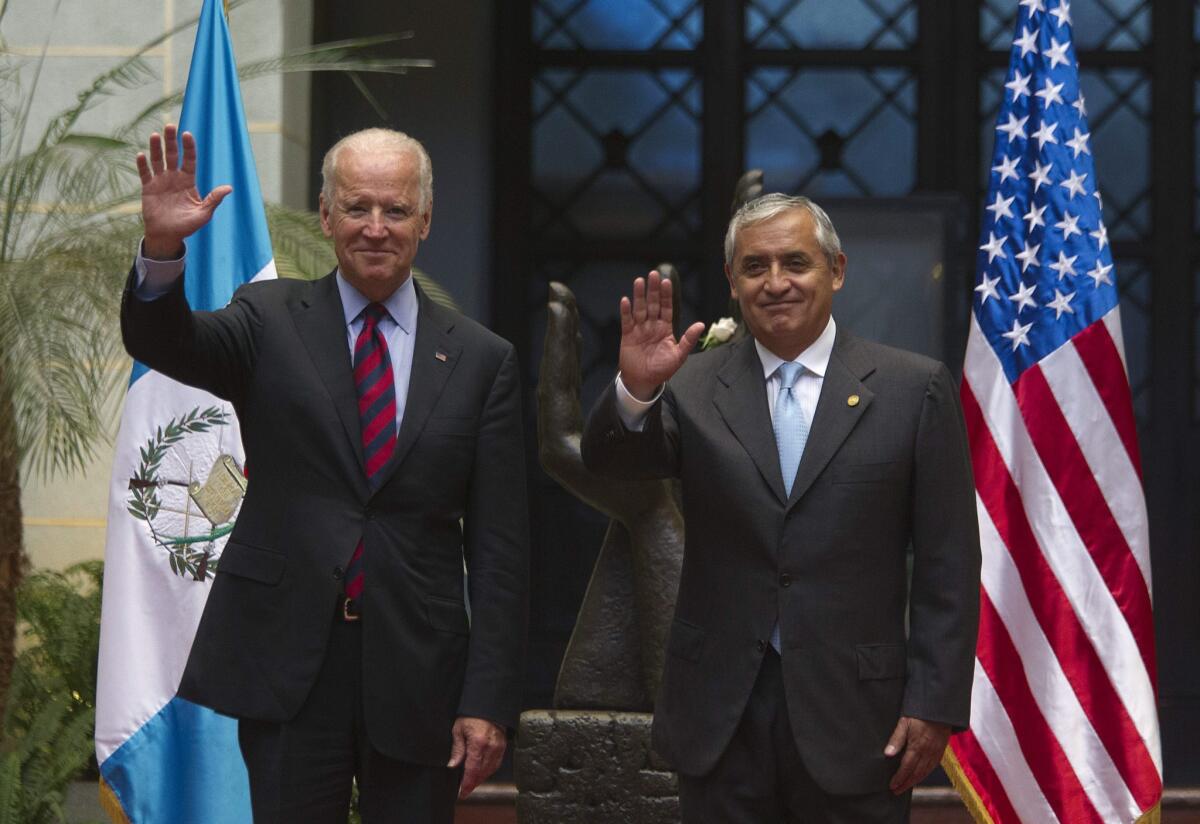A renewed surge of migration from Central America could pose early test for a President Biden

- Share via
WASHINGTON — Vice President Joe Biden was spending much of his time on Iraq a year into President Obama’s second term when he got a phone call from the president asking him to turn to a situation a little closer to home.
A “plethora of children” was “headed toward the border from Honduras, El Salvador and Guatemala,” Biden said last year, recounting the conversation. “He said, ‘Come home, take care [of it], do something.’”
The region had not been high on the administration’s priority list, but immigration was. And as the crisis of migrant children caught officials flat-footed, Biden became the administration’s point man for managing it.
Now, as Biden heads toward election day as a strong front-runner, U.S. officials and others say evidence is mounting that another surge of migrants is starting to build in Guatemala, Honduras and El Salvador — Central America’s Northern Triangle. For Biden, if he wins, a renewed crisis of children and families coming to the border could provide an early test.
Biden has sought to distance himself from some parts of the Obama administration’s immigration policies, saying at his second debate with President Trump last week that the administration made a “mistake” by putting too much emphasis on deportations.
At the same time, he has also said the U.S. needs to show it can control its borders and has been wary of policy changes that might spark a sudden rush of migrants. And his own history with the issue is complex.
Asked at the debate why voters should trust that he will make good on his campaign pledge to overhaul immigration, he said he had learned from the Obama administration’s experience.
“We made a mistake. It took too long to get it right,” he said.
‘It just kind of exploded’
In 2013, Homeland Security agencies began to notice an unexpected uptick in arrivals of Central American families and lone children in South Texas, according to Ben Rohrbaugh, then a senior department advisor. Rohrbaugh recalls a Border Patrol agent telling him the issue of unaccompanied children had “started to take over his life.”
Former Homeland Security Secretary Janet Napolitano, who left the administration in September 2013 to become president of the University of California, said in an interview that the migrant crisis burst suddenly onto officials’ list of top concerns.
“It was a slow increase over some months, and then it just kind of exploded,” she said.
In the 12 months ending September 2012, roughly 24,000 children came alone to the U.S. southern border, almost all from the Northern Triangle. Two years later, nearly 70,000 unaccompanied kids arrived. The numbers of Central American families spiked just as quickly.
By the time Rohrbaugh moved to the White House in 2014 to be director of border enforcement at the National Security Council, meetings on the issue became like a “drumbeat.”
A deadly cocktail of poverty, public corruption, and violence from gangs founded in the U.S. then deported to the region have contributed to the Northern Triangle nations having among the world’s highest homicide rates, creating an environment of fear and insecurity that prompts many to try to flee.
During Obama’s second term, the longtime understanding in the region that U.S. law afforded migrants the right to seek asylum and gave unaccompanied minors certain humanitarian protections morphed into a belief that migrants could receive permisos to stay in the U.S. indefinitely, officials said.
As the presidential election nears, Democrats and Republicans are targeting Florida’s other Latino voters, not just Cuban Americans and Puerto Ricans.
In Washington, meanwhile, the administration’s immigration policy had been driven by an implicit trade off: Obama hoped that if he demonstrated that his administration had delivered on border security, he could gain support in Congress for sweeping immigration reform, for which both parties had called for decades.
Those enforcement efforts angered many immigrant-rights activists, who in his first term had dubbed Obama the “deporter in chief,” and they strained relations between the administration and some Latino elected officials.
Rep. Norma Torres (D-Pomona) said she worked closely with Biden after she was elected in 2014 — the first-ever member of Congress born in Central America. She expresses lingering disappointment at Napolitano and other Obama-era officials for not doing more to resist putting “politics before humanity.”
“I’m realistic — we simply can’t help every single person that comes to our southern border,” Torres told The Times. “But we have not told that story of why these people are fleeing.”
By the time the child-migrant numbers began to surge, the legislative effort at immigration reform had failed — a victim of Republican opposition in the House to anything that conservatives would see as “amnesty.”
But officials said they feared that failure to contain the migration flow would serve as an invitation for even more migrants to try the dangerous, often deadly, journey north.
The administration responded in 2014 by separating hundreds of Central American families, citing concerns for the children’s safety; holding them in hastily thrown together tent facilities and on military bases; and beginning a system of family detention that persists today despite adverse court rulings.
While calling the administration’s policy a “mistake,” Biden at the debate rejected comparison between the Obama administration’s short-term, emergency response and the Trump administration’s more intentional policy of separating families explicitly for deterrence.
Hundreds of families separated under Trump remain apart, and court-appointed researchers and lawyers have been unable to locate the parents of about 545 migrant children who were taken from their families, according to recently filed court documents.
“They separated them at the border to make it a disincentive to come to begin with,” Biden said.
As Trump pressed: “Who built the cages, Joe?” Biden responded, “Their kids were ripped from their arms and separated. And now they cannot find over 500 sets of those parents and those kids are alone. Nowhere to go, nowhere to go. It’s criminal. It’s criminal.”
Former Obama administration officials in interviews similarly drew a distinction between what they called crisis management and Trump administration actions they described as intentionally cruel and punitive. Yet in Obama’s final years, officials also conceded their moves were intended in part to send a familiar message: Don’t come.
Beyond the domestic political fights, the Obama administration also pursued a foreign policy strategy in which Biden took the lead.
In July 2014, Mexican President Enrique Peña Nieto announced his Southern Border Program to step up Mexico’s immigration enforcement. The policy was aimed at effectively moving U.S.-Mexico border enforcement south to Guatemala, with Mexico taking the lead in blocking migrants moving north.
For most years since, Mexico has removed more Central Americans than the United States.
The administration, in turn, pursued a $750-million “Alliance for Prosperity,” a plan drafted by Northern Triangle leaders and announced by Biden under which the U.S. provided economic and security assistance through the end of Obama’s tenure.
In December 2014, the administration established the Central American Minors refugee program, allowing children and their families to apply for U.S. protection before leaving their home countries. Trump ended that program in one of his first moves in office.
Critics at the time said the Obama-Biden strategy put too much emphasis on security over development. Whether it would have worked remains unknown because of Trump’s abrupt shift in policy.
In Obama’s last year, nearly 78,000 family units and 60,000 unaccompanied children came to the border. In 2019, before the Trump administration effectively and indefinitely closed the border, citing COVID-19, almost 474,000 family members and 76,000 unaccompanied children arrived.
Today, Biden’s campaign platform outlines a strategy similar to Obama’s — work with Congress to pass comprehensive immigration reform, coupled with a four-year, $4-billion regional program to combat “factors driving migration.”
Whoever wins will have a tough time rebuilding trust, said Torres, who noted civil war “stole” her opportunity to grow up in Guatemala. Beyond merely discouraging migration to the U.S., she said, “We cannot allow narco-traffickers and public corruption to steal those futures from those little girls.”
For Biden, the 2014 experience remains an important touchstone.
On a June 2014 trip to Guatemala, Biden advocated longer-term solutions, but made clear U.S. assistance was tied to avoiding a repeat of the unaccompanied-minors crisis, “a tragedy we all must take responsibility for — the country from which they come, and the country to which they are headed.”
The U.S. was stepping up enforcement, he said, “because those who are pondering risking their lives to reach the United States should be aware of what awaits them.”
“It will not be open arms.”
Staff writer Tracy Wilkinson contributed from Washington.
More to Read
Get the L.A. Times Politics newsletter
Deeply reported insights into legislation, politics and policy from Sacramento, Washington and beyond. In your inbox twice per week.
You may occasionally receive promotional content from the Los Angeles Times.









